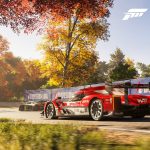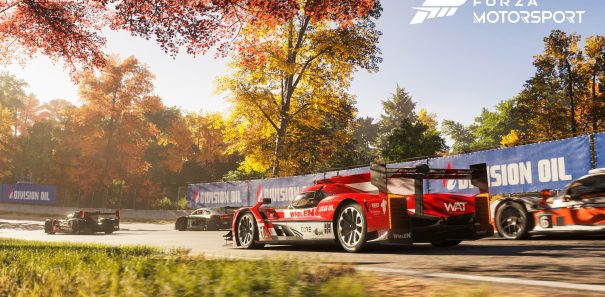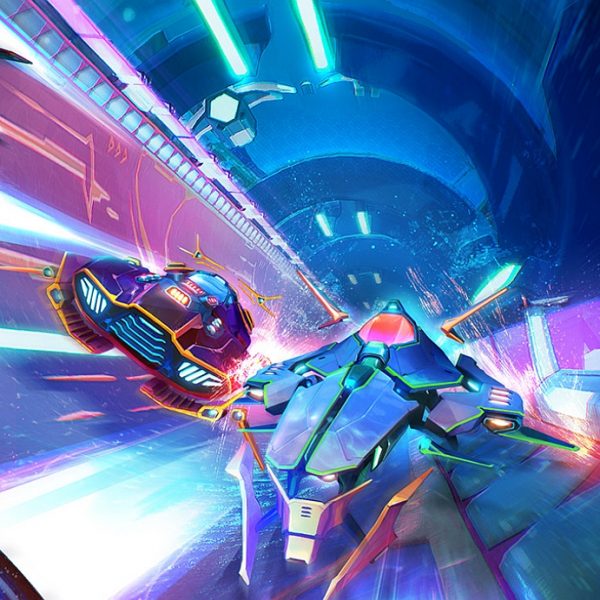As one of the longest running racing game series spanning over 20 years, Need for Speed has often had to reinvent itself to stay relevant. It’s no surprise, then, that the series has started to suffer an identity crisis: over the years we’ve seen Need for Speed transform from a realistic road racer, to an arcade Chase HQ-style cop chaser, to a thoroughbred track racing simulation and everything in-between, incorporating car customisation, drag racing, drift runs and even an epic cross country race throughout its many iterations.
For all its merits, the last entry in the series Need for Speed Rivals felt like a best of compilation that failed to really distinguish itself, combining the high speed police chases and open world of Criterion’s Hot Pursuit and Most Wanted. It was an enjoyable launch title in its own right, but it simply wasn’t the radical revolution the series needed to stay relevant in its jump to current-gen consoles.
With this in mind, Swedish studio EA Ghost Games spent an extra year developing the follow-up to Rivals, using the time to re-evaluate Need for Speed’s core credentials. Simply called Need for Speed, Ghost Games’ latest entry is a series reboot that aims to redefine the essence of Need for Speed. By popular demand, Need for Speed takes its key inspiration from the best-selling Underground series, bringing back the illegal night time street racing, extensive car customisation and open world driving that cemented Underground as a firm fan favourite.

Night rider
First things first: Need for Speed is a phenomenally pretty game. Running on EA’s advanced Frostbite engine, the lighting on display is best in class, with bodywork and puddles casting convincing reflections from multiple light sources such as headlights and street lamps to create a dazzling neon-lit light show. Its stunning realism makes for an awe-inspiring spectacle at times, resulting in one of the most visually impressive open worlds in a game to date.
Unfortunately, it’s also one of the dullest. Need for Speed is set in a perpetually nocturnal, rainy city known as Ventura Bay that’s loosely based on Los Angeles. If New York is the city that never sleeps, Ventura Bay is the city that always sleeps. While the prevailing darkness suits the shady street racing theme, it soon becomes samey. There are at least dawn lighting conditions as well, but watching the day transition from night, to dawn and then back to night again is extremely jarring.
There’s just about enough variety since Ventura Bay is divided into several distinct districts such as downtown, a harbour side, freeways and a twisting mountain pass that recalls memories of Need for Speed Carbon’s intense canyon duels, but there aren’t any memorable landmarks to give the city some much-needed character. Being set at night, the desolate streets of Ventura Bay are also mostly devoid of traffic which doesn’t make the city very interesting to explore. Compared to other open world racing games such as Forza Horizon 2 and particularly The Crew, Ventura Bay’s map size is somewhat small, too, despite apparently being twice the size of Rivals’ open world, resulting in racing routes often repeating the same roads.
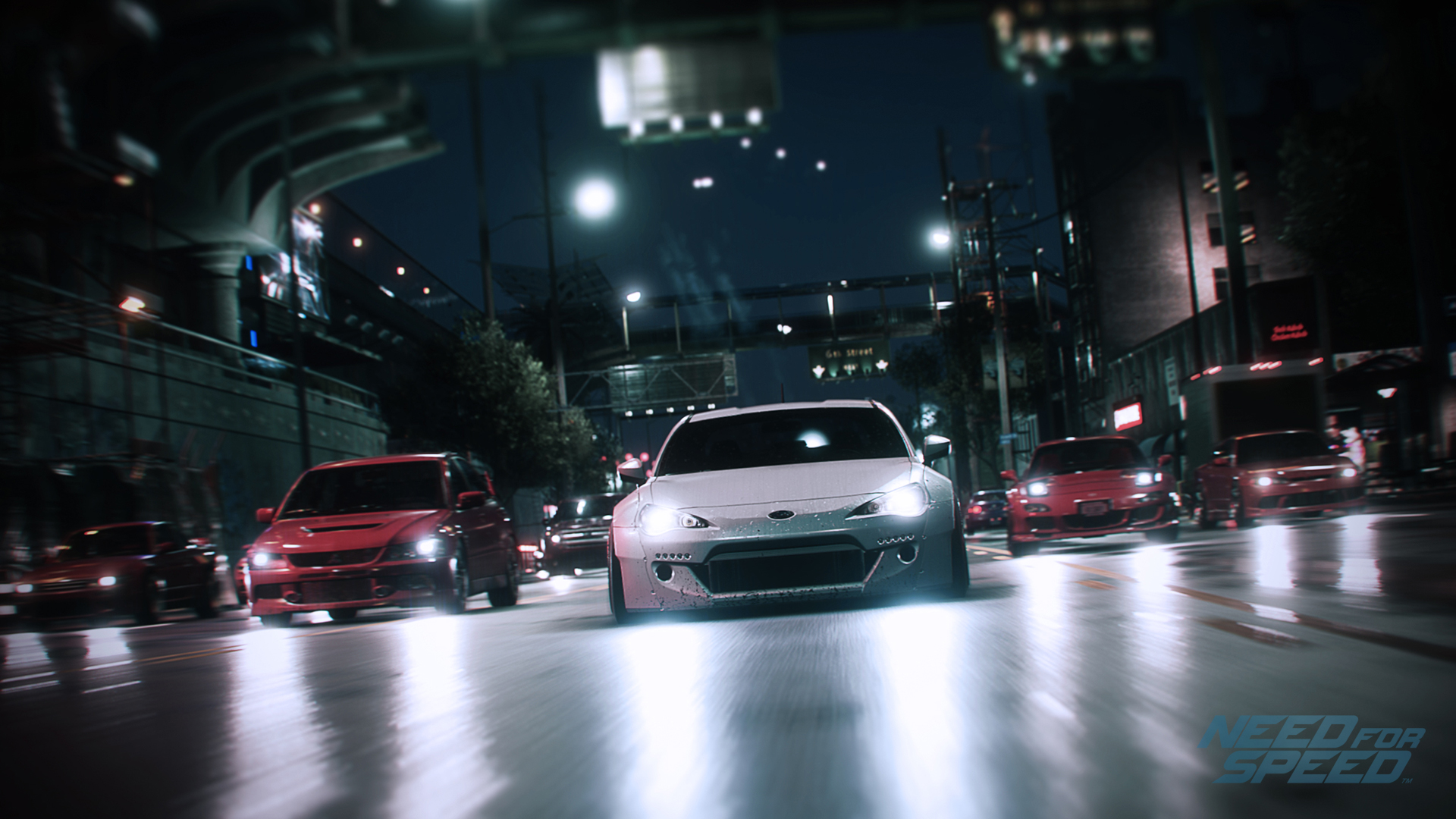
You’ll be cruising the streets of Ventura Bay to a soundtrack consisting mostly of electronic and rap music from artists such as The Chemical Brothers, Avicii and Zeds Dead. While the song selection doesn’t reflect my personal music taste, it fits the urban theme, and the soundtrack changes depending on the event you’re playing which is a nice touch. Drifting is accompanied with fast paced punk rock blaring from your speakers, for example, while cruising the streets will switch to some soothing electronica.
Lifting the bonnet
Car customisation is back at the forefront of Need for Speed after being mostly absent since Need for Speed Underground aside from a few cosmetic options. There’s a huge assortment of aftermarket parts from real world suppliers available to purchase: you can fit vulgar bodykits and inappropriately-sized spoilers to your car if you so desire, making it resemble the sort of souped-up car you might see lurking in a supermarket car park in the early hours of the morning.
The range of performance parts is equally extensive, from upgrades to the fuel system, camshaft and engine block to equipping nitrous. Upgrading your car is essential to stay competitive when the difficulty ramps up in later events, but, unlike the cars, performance upgrades are capped by Rep levels.
Keen modders will spend most of their time in Need for Speed’s detailed wrap editor, which allows you to create your own custom liveries using preset shapes, designs and logos, share them with the community (bizarrely, the ability to share designs was only recently possible after an update) and use the colour picker to create some garish paint jobs. The editor can be fiddly to use at times, and it’s not as versatile as Forza, but it’s still a step up for Need for Speed nonetheless and certainly a step in the right direction.
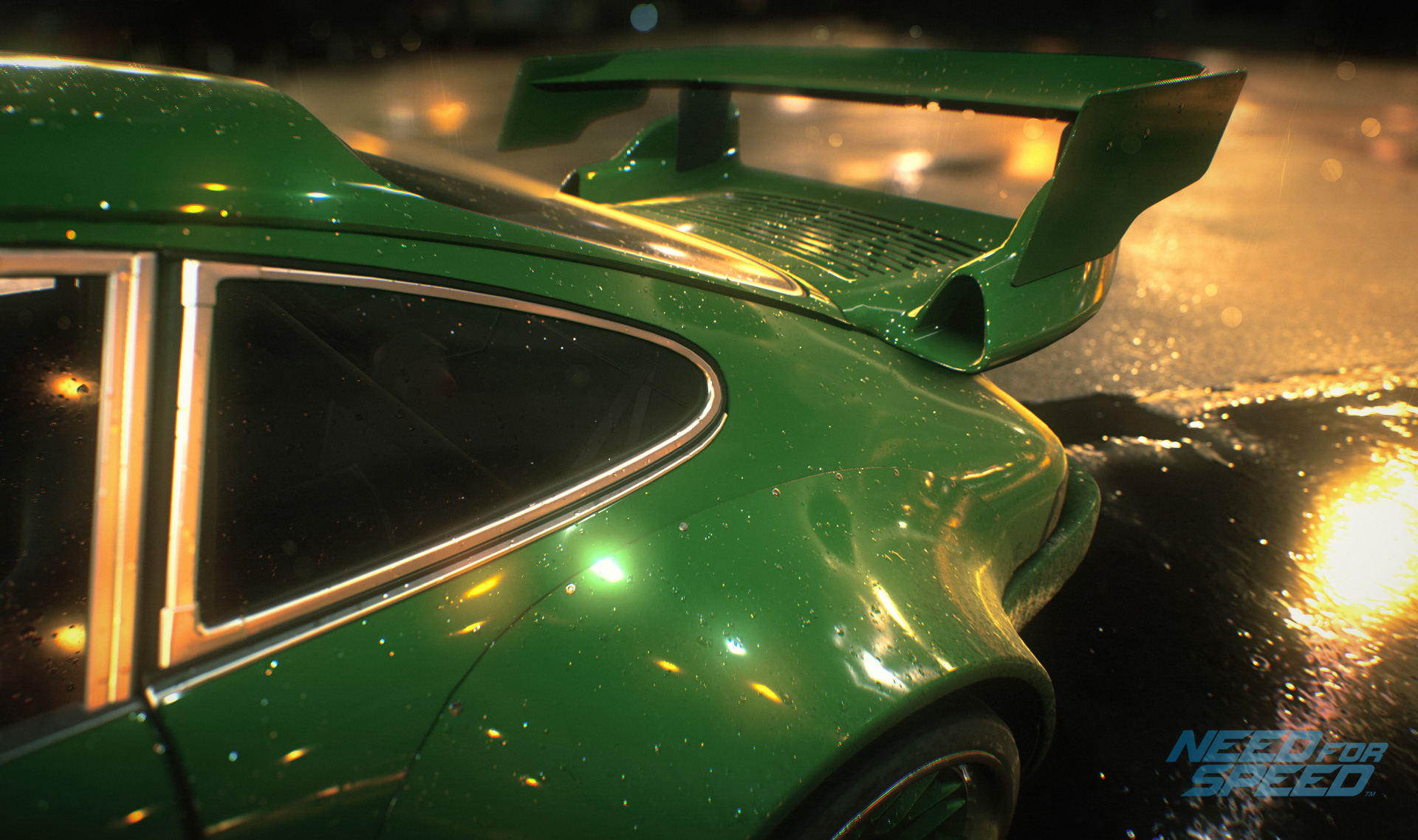
Sadly, the level of customisation you can apply isn’t consistent across all cars: save up for some of the more expensive cars from Ferrari and Lamborghini, and you’ll be disappointed to find that most parts can’t be changed. Licensing restrictions likely played a big part here, particularly as manufacturers like Ferrari are notoriously reluctant to let you tinker with their cars in racing games, but it contradicts Need for Speed’s strong car customisation ethos.
Needing more speed
Need for Speed’s meagre car selection leaves a lot to be desired. As you’d expect from a Need for Speed game, there are plenty of Porsches and BMWs spanning several generations (there’s a vintage first-gen Porsche 911 and a brand new 2016 BMW M2 coupé which makes its racing game debut in Need for Speed), but there are only a handful of muscle cars and exotics making up the 50-car strong car list.
Manufacturers you’d expect to see from past Need for Speed games are also nowhere to be found: Aston Martin, for example, fail to make an appearance in a Need for Speed game for the first time in years, while Koenigsegg, Jaguar and Bentley are also conspicuously absent, despite featuring in Need for Speed Rivals.
Compounding the small selection of cars is the fact you can only store up to five cars in your garage at a time. While the comprehensive customisation options help to make up for the sparse selection as it encourages you to spend more time with specific cars and gradually upgrade them, having to sell a car you’ve spent a lot of cash on modifying to make room in your garage when you buy a new car seems unnecessary when no other racing game has this restriction.

Speaking of unusual oversights in Need for Speed, there’s no option to select manual gears which prompted a lot of controversy. Indeed, it seems surreal to find a racing game released in 2015 without such an option, particularly as the ability to downshift would add more precision to the drifting. Of course, it’s been a long time since Need for Speed was aiming to be a realistic racer and the reboot is no exception, but even the original Need for Speed Underground, i.e. the game that the Need for Speed reboot arguably aspires to the most, released in 2003 had manual gears. It wouldn’t be so bad if the automatic gearbox was reliable, but there were many occasions when I was losing speed because it wouldn’t downshift.
The list of odd omissions goes on: there’s a bumper and bonnet camera, but no interior cockpit camera. Again, cockpit cameras haven’t featured in a Need for Speed game in over a decade, but part of the original Need for Speed game’s appeal was its ability to immerse you into the driving seat of an exotic sports car with its authentically recreated interiors. Cockpit cameras are now expected to be a standard feature in racing games, as Codemasters found out when they experienced a lot of backlash following their decision to remove the cockpit camera from Grid 2.
Car handling doesn’t stray too far from the established Need for Speed formula, with arcade-style physics that are easy to grasp. Each car doesn’t drive drastically differently, but they respond well, and a simple tap of the brakes will swing the back end out resulting in some satisfying drifting; although it doesn’t require a lot of skill to hold a slide.
In keeping with Need for Speed’s ethos to let you customise everything, the car handling can also be dialed to your preference for the first time, with options allowing you to change the tyre pressures and steering response on a basic level. It goes without saying that you shouldn’t expect a Project CARS’ level of depth as this is still an arcade racer at heart, but other settings let you delve deeper to tune the brake bias and spring stiffness among other aspects.
Alternatively, you can override these settings altogether by using a slider to tune your car for either drift or grip driving styles depending on your taste, although I found the cars understeer too much when set to grip. Instead, I achieved a sweet spot by setting the slider halfway between drift and the centre.
Style over substance
Need for Speed tries to cater to all tastes, featuring five separate career paths (Speed, Style, Crew, Build and Outlaw) appealing to different driving styles. Straight-up racers can conquer Speed events which offer standard circuit races and time trials, but if your driving style is more sideways then Style events are geared towards drift trials. Crew missions encourage team collaboration, whereas Build events test your ability to tune your car to win and Outlaw events focus on outwitting the law.
You can tackle each career in any order you like by teleporting to colour coded events on the map, and your actions during FreeDrive contribute to your rep score for each career, so successfully escaping the police and destroying property will earn you Outlaw points, drifting round corners will earn you Style points, performing a nitrous boost will earn you Build points, and so on.
Each career is represented by a story character who provide you with missions as part of the narrative in which a gang of street racers work to impress their racing idols. In a similar vein to Guitar Hero Live, Need for Speed’s story is told through a series of cringe-worthy live action cut scenes that play out in first person, featuring corny characters, some questionable acting and copious Monster Energy drink product placement. It’s probably not the best advertisement for the product if this is how you’ll turn out after drinking Monster Energy.
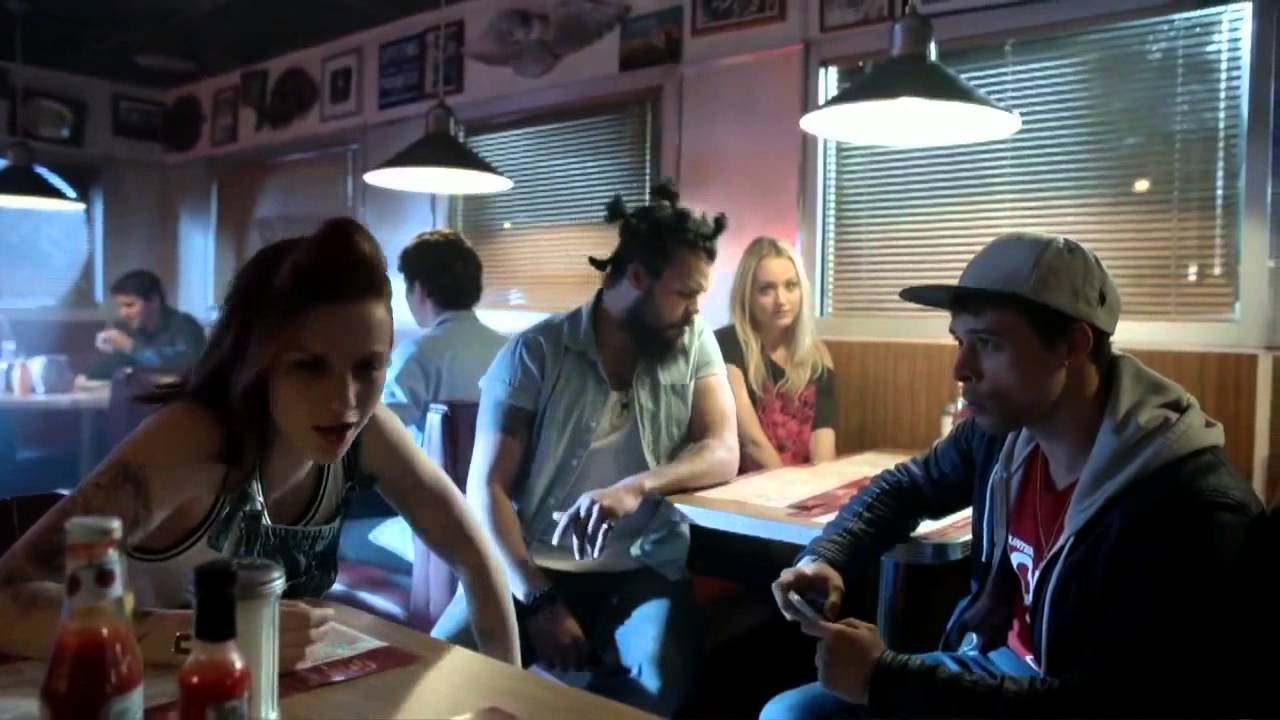
The awful acting alone makes it obvious that the cut scenes aren’t meant to be taken too seriously. Once you start treating them as the campy cut scenes they were intended to be they start to become fun to watch and you may even occasionally chuckle at some of the wisecracks and banter between characters. Having said that, the cast of characters boarder on unbearable at times thanks to the forced dialogue that sounds like it was written by a 13 year old. The story tries too hard to appeal to younger, social media-savvy audiences, throwing in buzz words like ‘bro’ ‘dope’ and ‘hashtag’ in practically every sentence. It’s certainly a strong case for stories having no place in racing games.
What makes the cut scenes particularly unengaging is the fact your character stays completely mute when the other characters talk at you, occasionally showing signs of life by taking a swig from a drink or engaging in some first person fist pumping. Worse still, the inconsiderate story characters constantly pester you on your phone like a clingy boyfriend or girlfriend as you’re driving to tell you about upcoming events – ironically, this sometimes happens when you’re already in an event. It’s a shame there isn’t an option to turn your phone off to shut them up.
In fairness, the cut scenes manage to pull off an impressive technical feat by blending the live action FMV with the in-game renders: it’s undeniably impressive to see the live action transition to your in-game car and a true testament to the tech powering Need for Speed.
Each career path eventually catches the attention of one of five real world racing icons steeped in car culture that the gang of racers aspire to, such as prolific Porsche collector Magnus Walker and humble hoonigan Ken Block, who make some awkward cameo appearances in later cut scenes. It’s still hard adjusting to seeing Ken Block appear in a non-Codemasters game.
Of course, if Ken Block is in your game then it’s only natural that Gymkhana (if you don’t know what Gymkhana is, just watch this in awe) will feature, and sure enough Gymkhana events make their debut in Need for Speed. They pale in comparison to DiRT’s faithful take on Gymkhana, which required some serious precision stunt driving, however, amounting to little more than standard drift trials against the clock in Need for Speed.

Outlaw events offer some of the more entertaining action, mixing standard events with the added pressure of fending off police in pursuit – or at least they would be if the police posed any serious threat. Cop chases have been drastically pared back compared to Need for Speed Rivals and Criterion’s Hot Pursuit and Most Wanted games.
In Rivals the police were overly aggressive and would constantly harass you, but in Need for Speed it doesn’t take much effort to evade them as soon as they give chase. You’ll often have to slow down to allow the cops to catch up if you want to maintain the pursuit and advance to the next heat level, which is a requirement for some Outlaw events. The police ramp up their tactics in later heat levels, becoming more aggressive and deploying roadblocks, but it’s a lot more grounded than before – you won’t be dodging spike strip powerups like in Hot Pursuit.
Drift train events also shake things up in the Style career, requiring you to chain drifts together whilst staying in close proximity with your crew, but they’re hampered by some aggressive AI. Sadly, standard races don’t fare much better, as they’re plagued with some frustrating rubber band AI no matter how much you’ve upgraded your car. This is a game where it’s possible for a Nissan 180X to keep up with your Porsche 911.
Need for Speed is the latest in a long line of games that are always online, which doesn’t work in its favour: not only does this mean that Need for Speed is inaccessible if the servers are down and will become obsolete when they inevitable get shut down in years to come, you can’t even pause the game which renders the photo mode pointless if you want to snap some action shots. Enforcing an online connection is totally unnecessary, particularly if you just want to focus on the single player events which make up a large portion of the game.
Need for Speed does little to justify requiring an internet connection. Rivals’ AllDrive system returns in Need for Speed, connecting you with seven other online players who seamlessly inhabit your world Test Drive Unlimited-style, but it suffers the same problems as before. With such a small number of players roaming the world, it’s rare you’ll find anyone willing to compete with you online since most players are already busy doing their own thing. You can set up racing crews and arrange meet ups, but it’s all so convoluted when a traditional matchmaking system would have sufficed. It’s also infuriating when a single player event gets interrupted by someone slamming into you head-on mid-race.
Elsewhere, Autolog Recommends once again pits you against your friend’s fastest times, but it’s not enough to keep you hooked as we’ve seen it all before. Without or an interesting city to explore or a compelling multiplayer component, there’s little incentive to keep coming back to Need for Speed once you’ve completed the short campaign other than some online daily challenges and collectibles to hunt down.
That’s a wrap
Need for Speed has enjoyed plenty of post-release support from Ghost Games, who have added several fan-requested features and fixes. The AI rubber banding has been addressed, more customisation parts have been added including underglow neons and you now have the ability to share custom wraps with the community.
A photo mode was also recently added, while manual gears and wheel support will finally debut in the long-awaited PC port of Need for Speed this spring, which will also benefit from an unlocked frame rate and up to 4K resolution. Trouble is, these aren’t exactly ground-breaking features to get excited about. You have to commend Ghost Games for listening to the community and releasing regular updates, which is more than can be said for some developers, but these are all features that should be standard in racing games anyway.
Need for Speed is slowly steering in the right direction for future games to follow. The exceptional car customisation has helped redefine the series and the five career paths offer a variety of driving experiences to suit multiple tastes, but it’s not the spectacular return to form it should have been.
Need for Speed has plenty of good ideas let down by some disconcerting design decisions: its flashy exterior can’t mask the fact it’s a severe case of style over substance.
Our Review
Summary
Need for Speed is slowly steering in the right direction for future games to follow. The exceptional car customisation has helped redefine the series and the five career paths offer a variety of driving experiences to suit multiple tastes, but it’s not the spectacular return to form it should have been. Need for Speed has plenty of good ideas let down by poor design decisions: its flashy exterior can’t mask the fact it’s a severe case of style over substance.









